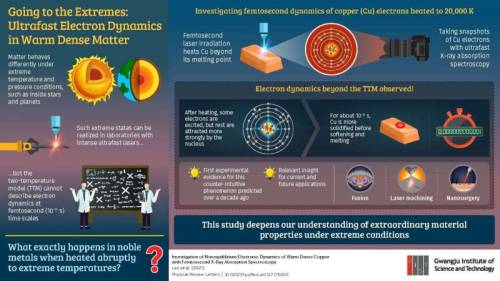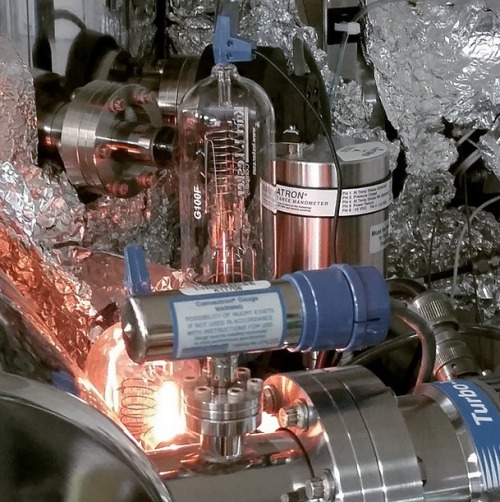#pressure
Oxide sintering by air pressure control
Professor Hiromi Nakano of the Toyohashi University of Technology has collaborated with a company to develop a small, lightweight air-pressure control atmosphere furnace that can rapidly and uniformly synthesize periodical structures of Li2O-Nb2O5-TiO2 (LNT) solid solution materials at 3x ordinary pressure. The underlying mechanism was discovered using detailed composition/structure analysis. As the sintering process is reduced by one-fourth compared to conventional electric furnaces, this technology can also be applied to other materials.
The air-pressure control atmosphere furnace is a sintering furnace that uses a regular 100 V AC power outlet and saves up to 800 W of energy. With this furnace, pressurized gas is supplied/controlled using a compressor or gas flow and materials can be heated up to 1,100 degrees C. (FIG. 1)
Post link
Scientists measure temperature under shock conditions
Temperature is tough to measure, especially in shock compression experiments. A big challenge is having to account for thermal transport—the flow of energy in the form of heat.
To better understand this challenge, researchers from Lawrence Livermore National Laboratory (LLNL) have taken important steps to show that thermal conduction is important and measurable at high pressureandtemperature conditions in these types of experiments, according to a paper recently published in the Journal of Applied Physics. The paper’s authors are David Brantley, Ryan Crum and Minta Akin.
“We need better temperature measurements because understanding rocky-type planetary materials’ high temperature and pressure behavior is key to developing better models of Earth and other terrestrial exoplanets,” said David Brantley, LLNL physicist and lead author of the paper.
Brantley said that depending on how iron conducts heat at Earth’s core pressure and temperatures, the planet’s solid inner core could be around 500 million to several billion years old.
Post link
Thor’s hammer to crush materials at 1 million atmospheres
Sophisticated features may influence eventual Z-machine rebuild
A new Sandia National Laboratories accelerator called Thor is expected to be 40 times more efficient than Sandia’s Z machine, the world’s largest and most powerful pulsed-power accelerator, in generating pressures to study materials under extreme conditions.
“Thor’s magnetic field will reach about one million atmospheres, about the pressures at Earth’s core,” said David Reisman, lead theoretical physicist of the project.
Though unable to match Z’s 5 million atmospheres, the completed Thor will be smaller – 2,000 rather than 10,000 square feet – and will be considerably more efficient due to design improvements that use hundreds of small capacitors instead of Z’s few large ones.
Remarkable structural transformation
This change resembles the transformation of computer architecture in which a single extremely powerful computer chip was replaced with many relatively simple chips working in unison, or to the evolution from several high-voltage vacuum tubes to computers powered by a much larger number of low-voltage solid-state switches.
Post link
Scientists reveal ultrafast melting dynamics in matter heated to extreme temperatures
Ordinary matter behaves very differently when subjected to extreme temperatures and pressures, such as that inside stellar and planetary cores. Conventional rules of condensed matter physics and plasma physics are not applicable in such scenarios. In particular, an extreme state known as “warm dense matter” (WDM) straddles the boundary of condensed matter physics and plasma physics.
One might think that such states can never be created in a terrestrial setting. But, in fact, short laser pulses that are only femtoseconds (10-15 s, or a quadrillionth of a second) long are intense enough to recreate such conditions in a laboratory. Conventional physical models that describe such states typically assume that electrons become excited by the laser pulse attain equilibrium within tens of femtoseconds while the ions remain “cold.” However, in doing so, the non-equilibrium dynamics of the electrons are completely disregarded.
Post link
First experimental evidence for superionic ice
Among the many discoveries on matter at high pressure that garnered him the Nobel Prize in 1946, scientist Percy Bridgman discovered five different crystalline forms of water ice, ushering in more than 100 years of research into how ice behaves under extreme conditions.
One of the most intriguing properties of water is that it may become superionic when heated to several thousand degrees at high pressure, similar to the conditions inside giant planets like Uranus and Neptune. This exotic state of water is characterized by liquid-like hydrogen ions moving within a solid lattice of oxygen.
Since this was first predicted in 1988, many research groups in the field have confirmed and refined numerical simulations, while others used static compression techniques to explore the phase diagram of water at high pressure. While indirect signatures were observed, no research group has been able to identify experimental evidence for superionic water ice – until now.
In a paper published today in Nature Physics, a research team from Lawrence Livermore National Laboratory (LLNL), the University of California, Berkeley and the University of Rochester provides experimental evidence for superionic conduction in water ice at planetary interior conditions, verifying the 30-year-old prediction.
Post link
materialsscienceandengineering:
e8u:
materialsscienceandengineering:
Cold sintering of ceramics instead of high-temperature firing
Both hobbyists’ pottery and engineered high-performance ceramics are only useable after they are fired for hours at high temperatures, usually above 1000 °C. The sintering process that takes place causes the individual particles to “bake” together, making the material more compact and giving it the required properties, like mechanical strength.
In the journal Angewandte Chemie, American researchers have now demonstrated that sintering can also take place at significantly lower temperatures. This cold sintering process is based on the addition of small amounts of water to aid the key transport processes that densify the material.
“Since the stone age, ceramics have been fabricated by sintering at high temperatures,” reports Clive A. Randall from Pennsylvania State University (USA). “This includes the Venus of Doli Vestonice, one of the oldest ceramic objects.” The traditional firing process may now become unnecessary for many ceramic materials, because a broad spectrum of inorganic materials and composites can also be sintered between room temperature and 200 °C.
Unfortunately, I don’t see the part where they talk about oxides. Abstract says it’s in the supporting information, but idk.
They used a die press to compact their samples to very high pressure, in the range of 80-570 MPa (11.6k - 86k psi). Cold isostatic pressing could make this work for more complex shapes. I wonder if the mechanical compaction of the particles is important, or if perhaps this could be done in an autoclave?
Thanks for the links! As far as I can tell, they don’t actually talk much about oxides. I think they just meant that to inform the reader that they had tried the process on several oxides (such as the ones listed in table 1 of the supporting information like ZnO2, ZrO, WO3, and MgO) and that it worked.
As for cold isostatic pressing vs. autoclaving? I don’t know. I am far from an expert, but autoclaves are typically used at higher temperatures and use steam to sterilize the samples. I’m not sure if that would work for samples like these, though, like I said, I don’t know much about the topic.
Anyone else have any thoughts?
My only concern I have would be the amount of material you could synthesize at one time since mega pascal pressures were used. I also feel you could use PXRD for phase ID, but the technique could limit use of other XRD methods, such as single crystal growth if you wanted to do that or even in situ maybe. Definitely an interesting paper though.
Post link
Aberrant electronic and structural alterations in pressure-tuned perovskite
The perovskite NaOsO3 has a complicated but interesting temperature-dependent metal-insulator transition (MIT). A team led by Drs. Raimundas Sereika and Yang Ding from the Center for High Pressure Science and Technology Advanced Research (HPSTAR) showed that the insulating ground state in NaOsO3 can be preserved up to at least 35 GPa with a sluggish MIT reduction from 410 K to a near room temperature and possible transformation to a polar phase. The work has been published in npj Quantum Materials.
NaOsO3 perovskite undergoes a metal-insulator transition concomitant with the onset of an antiferromagnetic long-range ordering at a Neel temperature of about 410 K, which is accompanied by a magnetic ordering without any lattice distortion.
The team carried out a combined experimental and computational study to understand the effect of external pressure on perovskite NaOsO3. They found hidden hysteretic resistance properties with a transient metallic state near 200 K. Also three electronic character anomalies (at 1.7, 9.0, and 25.5 GPa), and a structural transition to the singular polar phase (at ~ 18 GPa) were discovered.
Post link
Pressure is the prompt for this day 9 of Inktober! Here’s a fanart of Azshara from Warcraft, falling into the deeps of the Great Sea. We were wondering if turning this sketch into a painting one of those days ;)
Post link
I’m getting an iron infusion tomorrow then again a week later. Hopefully that will help with my constant need to nap. But the pressure in my head is getting worse. I can’t get an MRI until this Corona shit calms down. In the meantime I’m fucking dying. I don’t know what to do. I need something to help with the pressure and pain. And I’m told to “hang in there”. Fuck you and fuck everyone for punishing me and trying to make me feel bad for attempting suicide.
Ion gauges on one of our deposition systems.
Ionization gauges are commonly used to measure pressure in high vacuum. They look and operate very much like a light bulb. Electrons are emitted from a central heated filament (the glowing part) and accelerated toward a helical wire or “grid” around the filament. Some of these electrons collide with gas molecules and ionize them. The ions are then attracted to a collector filament, creating a current which can be measured. The magnitude of the ion current depends on the pressure and composition of the gas.
Post link
Day 9: Pressure
This was a hard one too.
Almost did a self portrait of me drawing Inktober prompts
Post link
There is this feeling I get after my heart breaks, metaphorically of course, I do know hearts are muscles and do not break, but when something that felt so real and so infinite ends, I cannot help but feel like my body is physically hurt.
It feels like my ribs are breaking, one after another, in different spots and they keep breaking and breaking, putting more and more pressure on my chest, making it impossible to breathe. I feel the air coming through my nose and never making it down my windpipe because it is being crushed by my chest collapsing into itself. There is sharp pain in my throat when air touches it and soon I cannot breathe at all. My eyes hurt, they are bloodshot, bleeding, blood dripping down my face onto the ground and it hurts. My body is shaking and there is no way to stop it, it moves with every inhale and exhale and even when my chest is broken down and barely gets air through, my body still shakes, my muscles keep cramping, contracting stronger and faster and at some point, my body does not handle it any more. It shuts down.
Then a new kind of pain begins. There is a headache I can feel right in the center of my forehead. It starts there, where the emotions are controlled, it starts where everything started to fall apart. If feels like every single cell there is shutting down, either dying or slowly burning to death. It almost feels like needles stabbing every single one of them, making the brain unable to control whatever is going on. It moves up and affects my thinking, making me believe there is nothing left for me in the world, making me believe, there is no plan, no future.The pain spreads to the top of my head, makes it unable to move, makes my whole body hurt again, all the ribs breaking, the body shaking, now it gets worse. It affects the vision and makes it even blurrier and all I see is him in front of me, everywhere I look and that hurts even more.
After my whole brain feels like it is bleeding out and being torn apart, the last part of brain starts to hurt. The little piece of where every perfect memory is stored, where memories of first dates, kisses, ‘I love you’s and so much more, live, that is the part that hurts the most. This little part is the main reason the whole brain is hurting, the only reason my body is breaking. The memory of perfect little moments of time we shared is why breakups make me think there is something physically wrong with me when it happens, because it does affect my whole body, it affects every cell that lives inside me and all of them start hurting at the same time.

Yeast is a key ingredient in many pizza doughs; as the yeast ferment sugars in the dough, they produce carbon dioxide which bubbles into the dough, creating the light and airy texture necessary for a good crust. It’s a slow process, though, often requiring several hours for the dough to rise. Recently, researchers studied an alternative pizza-making method that generates bubbles in the dough via pressurization – with no yeast required. (Image credit: B. Huff; research credit: P. Avallone et al.)
Read the full article

“A Gem could crack under so much pressure. We Diamonds may be hard, but we’re also brittle.”
Day 9-Pressure
divisionart00-deactivated202204:
My heart was already beating fast and hard, so of course I wanted to torture it with pressure as well. It struggled under the weight and tried to quit a couple of times, but didn’t quite manage to stop.
❤️
Parents trying to patiently wait for their children as they come out of the first day of Gaokao, the Chinese College entrance Exam. There are police officers and fire men there to control the crowd.
Post link
#VIEWS4D3RDEYE:Bree Runway gives us life, looks, and excellence in “Pressure.”















